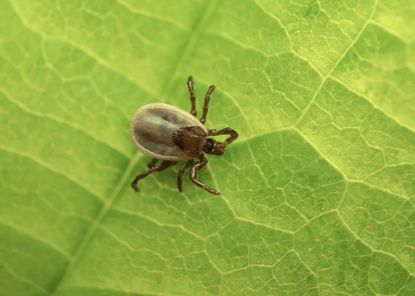Rise of the ticks
Tick- and mosquito-borne diseases are a growing danger of the American outdoors

Tick- and mosquito-borne diseases are a growing danger of the American outdoors. Here's everything you need to know:
How serious is the threat?
It's become a real concern for anyone who spends time in the outdoors. Ticks and mosquitoes that can be found in backyards, the woods, fields, and even cities are transmitting Lyme disease, anaplasmosis, babesiosis, Rocky Mountain spotted fever, and a host of other illnesses. Reported cases of these diseases more than tripled between 2004 and 2016, according to the Centers for Disease Control and Prevention. Part of that rise, from 27,388 cases to 96,075, is attributable to the mosquito-borne Zika outbreak in South Florida in 2016. But tick-borne illnesses are truly epidemic, with a doubling of reported cases over that period, as the bloodthirsty arachnids expand into new regions of the U.S. Scientists have also discovered nine new vector-borne diseases, some of them potentially fatal. "These are more than summertime nuisances," says Lyle Petersen, director of the CDC's Vector-Borne Diseases division. "People really do need to take this seriously."
Subscribe to The Week
Escape your echo chamber. Get the facts behind the news, plus analysis from multiple perspectives.

Sign up for The Week's Free Newsletters
From our morning news briefing to a weekly Good News Newsletter, get the best of The Week delivered directly to your inbox.
From our morning news briefing to a weekly Good News Newsletter, get the best of The Week delivered directly to your inbox.
Why is this happening?
Climate change appears to be a major factor, with warmer temperatures enabling disease-spreading bugs to thrive in areas they used to find inhospitable. The number of counties deemed high-risk for Lyme, which affects an estimated 300,000 Americans a year (many cases are not reported), has increased by more than 320 percent since the late 1990s; northern states such as Maine and Vermont used to be too cold for the deer ticks that carry Lyme, but are now crawling with them. Warmer temperatures also reduce the amount of time it takes for ticks to mature, and increase the period over the summer in which the parasites are active. The other driving factor is suburbanization. Deer ticks mostly feed on mice and deer — that's also where they pick up the bacteria — so the closer people are to them, the higher their chances of exposure. "Once you start to carve up the forest into little bits," says Richard Ostfeld of the Cary Institute of Ecosystem Studies, "you get an increase in Lyme risk."
How dangerous are these diseases?
Most are bacterial, so if the infection is caught early, antibiotic treatment is usually effective. More serious problems arise when people don't realize they've been infected, and the bacteria have a chance to spread throughout the body, including the nervous system. Lyme disease is notorious in this respect. Up to 20 percent of patients continue to experience symptoms such as severe headaches, joint pain, facial palsy, heart palpitations, and neurological issues, long after the course of antibiotics has ended, for reasons that are not understood. Lyme is almost never fatal, but other bacterial tick-borne diseases can be, including Rocky Mountain spotted fever, which is carried by dog ticks and wood ticks. Some tick-borne diseases are viral, and thus cannot be treated with antibiotics. Powassan virus can cause permanent brain damage and lead to death; also potentially deadly are the recently discovered Heartland and Bourbon viruses.
What about mosquitoes?
Like ticks, mosquitoes are spreading because of climate change. Long periods of sub-freezing temperatures that used to kill off certain kinds of mosquitoes — including the Aedes species that spreads dengue, yellow fever, and Zika — are no longer guaranteed. Warmer temperatures enable the insects to survive farther north, and increase the amount of time they're active. In 10 U.S. cities, the warm and humid mosquito season is as much as a month longer than it was in 1980. Mosquito-borne illnesses are also increasing because of globalization. People travel around the world far more than they used to and can take home diseases as unwanted souvenirs. Once exotic viruses such as Zika and chikungunya "are basically a plane flight away," says Petersen.
Are there vaccines for these diseases?
Only yellow fever has a Food and Drug Administration–approved vaccine. There used to be one for Lyme too, called LYMErix, but it was taken off the market in 2002 after a scare about its side effects. Pharmaceutical companies are working on a replacement — as they also seek vaccines for Zika, West Nile, and others — but they haven't yet succeeded. Scientists are trying all sorts of other methods to prevent bugs from spreading disease. In one study, researchers targeted ticks by tricking their hosts — deer and mice — into brushing up against materials containing anti-tick chemicals. For mosquitoes, the most promising technique appears to be flooding the target area with sterile or genetically modified males; then, when they mate, the females don't produce viable offspring. But whether any of these tactics will work on a large scale remains to be seen. For now, people just have to be careful in high-risk areas: avoid walking in long grass, where ticks lie in wait to climb onto passing mammals; wear bug repellent and cover up as much skin as possible; and search for — and remove — ticks after spending time outside. "This is one concern in life that's preventable by following some simple guidelines," says David Weber, an epidemiologist at the University of North Carolina. "So it's worth taking precautions."
Catching a meat allergy
While most tick-borne diseases cause flu-like symptoms, one causes a truly bizarre reaction: a severe allergy to red meat. Several hundred Americans a year now get that condition from a single bite from a lone star tick, a species found in the eastern half of the U.S. Named for the single white dot on the adult female's back, the lone star carries a sugar molecule called alpha-gal. When the tick bites someone, it rewires that person's immune system to produce antibodies that fight alpha-gal — and alpha-gal happens to be abundant in red meat. Symptoms include hives, a runny nose, and a constricted throat. The reaction can take hours to manifest and doesn't happen every time an infected person eats meat, making it hard to diagnose. And there is no known cure. While the CDC doesn't collect data on the condition, anecdotal evidence suggests that, like all tick-borne diseases, alpha-gal allergy is becoming increasingly common. "Five years ago, we probably had about 50 or so patients," says Cosby Stone, an allergy and immunology fellow at Vanderbilt University. "Now we have about 200."
Create an account with the same email registered to your subscription to unlock access.
Sign up for Today's Best Articles in your inbox
A free daily email with the biggest news stories of the day – and the best features from TheWeek.com
-
 Georgia's new foreign influence bill
Georgia's new foreign influence billUnder the Radar Critics claim the 'Russian law' could stifle dissent and wreck the country's chances of joining the EU
By Elliott Goat, The Week UK Published
-
 'Making a police state out of the liberal university'
'Making a police state out of the liberal university'Instant Opinion Opinion, comment and editorials of the day
By Harold Maass, The Week US Published
-
 8 looming climate tipping points that imperil our planet
8 looming climate tipping points that imperil our planetThe Explainer New reports detail the thresholds we may be close to crossing
By Devika Rao, The Week US Published
-
 Do unvaccinated COVID patients deserve scarce care? A doctor weighs in.
Do unvaccinated COVID patients deserve scarce care? A doctor weighs in.The Explainer Justice, judgment, and the last ICU bed
By Bonnie Kristian Published
-
 How to vaccinate the anti-vaxxers
How to vaccinate the anti-vaxxersThe Explainer Instead of blaming people for not doing the right thing, let's focus on eliminating the obstacles to vaccination that still remain
By Noah Millman Published
-
 The U.S. could double its COVID-19 vaccine availability overnight. What's the holdup?
The U.S. could double its COVID-19 vaccine availability overnight. What's the holdup?The Explainer How the FDA could approve a more efficient vaccine rollout
By Bonnie Kristian Published
-
 COVID-19 keeps proving everyone wrong
COVID-19 keeps proving everyone wrongThe Explainer Our coronavirus culture war is no match for the virus
By Noah Millman Published
-
 The October Surprise nobody wanted
The October Surprise nobody wantedThe Explainer Trump has COVID-19. Really, 2020?
By Peter Weber Published
-
 Life is worth living
Life is worth livingThe Explainer What's driving America's rising suicide rate?
By Matthew Walther Published
-
 Social workers are masters at de-escalation. Here's what the police can learn from them.
Social workers are masters at de-escalation. Here's what the police can learn from them.The Explainer Knowing how to peacefully resolve conflict, rather than exacerbate it, can save lives
By Tonya Russell Published
-
 Settling in for the long pandemic
Settling in for the long pandemicThe Explainer Life won't be back to "normal" anytime soon
By Jeva Lange Published